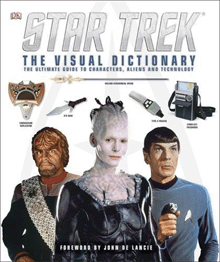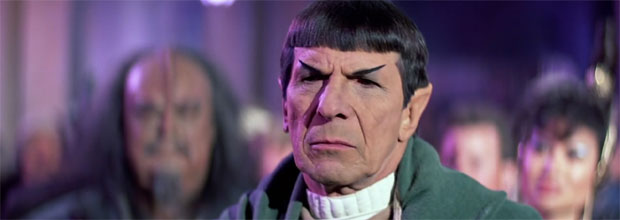 Few sci-fi shows have a rich universe of history surrounding them like Star Trek. For the longtime fan a familiarity with such lore is a comforting aspect of viewing, but for the casual watcher who doesn’t know their arse from their Bolian, it can be as intimidating and intriguing as a Tholian web.
Few sci-fi shows have a rich universe of history surrounding them like Star Trek. For the longtime fan a familiarity with such lore is a comforting aspect of viewing, but for the casual watcher who doesn’t know their arse from their Bolian, it can be as intimidating and intriguing as a Tholian web.
Whichever category you fall into, Paul Ruditis’ Star Trek: The Visual Dictionary is just the companion you need.
It’s a superb glossy guide, with 96 pages of photos detailing every nacelle and cranny of the Star Trek universe that existed in 5 TV series and 10 movies before JJ Abrams ignited the red matter and rebooted it in a blaze of lens flare. You’ll find no shots of Chris Pine’s jawline here, but you will be treated to lovely big pictures of everything from the good ol’ NCC-1701 Enterprise to decorative minutiae like a Flaxian Assassin’s Perfume Case or Captain Sisko’s Saltah’Na Clock. Yet not one alien toilet. Fascinating, Captain…
If page after page of outer space aesthetics sounds incredibly geeky then yes, it is, but resistance to this book’s charms is futile. From the first page you’ll be drawn in by the eye-catching layouts and orbiting trivia. Pulled past the event horizon of acceptable Star Trek trivia knowledge into a place where you’ll learn about alien wedding rituals and interstellar politics.
 The Visual Dictionary is an omnipotent overview of Star Trek; a warp speed tour of Gene Roddenberry’s universe that allows you to take everything in, like a member of the Q-Continuum, without getting mired in continuity. Biographies and facts are kept pleasingly brief so as to be easily digestible and to take up minimum space. Only the notable recurring species like Klingons and Andorians are given their own pages (if you’re looking for a niche species like Voyager‘s dinosaury Voth, or Nazi Ghraths from Enterprise then move along).
The Visual Dictionary is an omnipotent overview of Star Trek; a warp speed tour of Gene Roddenberry’s universe that allows you to take everything in, like a member of the Q-Continuum, without getting mired in continuity. Biographies and facts are kept pleasingly brief so as to be easily digestible and to take up minimum space. Only the notable recurring species like Klingons and Andorians are given their own pages (if you’re looking for a niche species like Voyager‘s dinosaury Voth, or Nazi Ghraths from Enterprise then move along).
This broad brushstrokes approach means it’s comprehensive yet at the same time accessible, and each detailed shot shows as much an appreciation for the props, costume design, and SFX departments of the franchise as for the fictional stories behind them. This is a book where the images do the talking.
If there’s one gripe it’s that it’s so succinct in places that the movies aren’t quite as well represented as some might like. Fan favourite Khan Noonien Singh doesn’t get a look in, yet pantomime Generations villain Dr. Soran gets half a page, and Tom Hardy’s Shinzon (the singular redeeming part of Nemesis), is only mentioned in passing. They’re small but niggling omissions.
Nevertheless this is a great guide for any Trekkie/Trekker who wishes to revel in the nostalgia of their favourite era of the show, and a particularly good gift if you’ve a young family member who’s just starting to boldly join the franchise. Star Trek: The Visual Dictionary comes highly recommended.
![]()
Published in Friday 1 March 2013 by Dorling Kindersley.
What do you think of the book? Let us know below…

